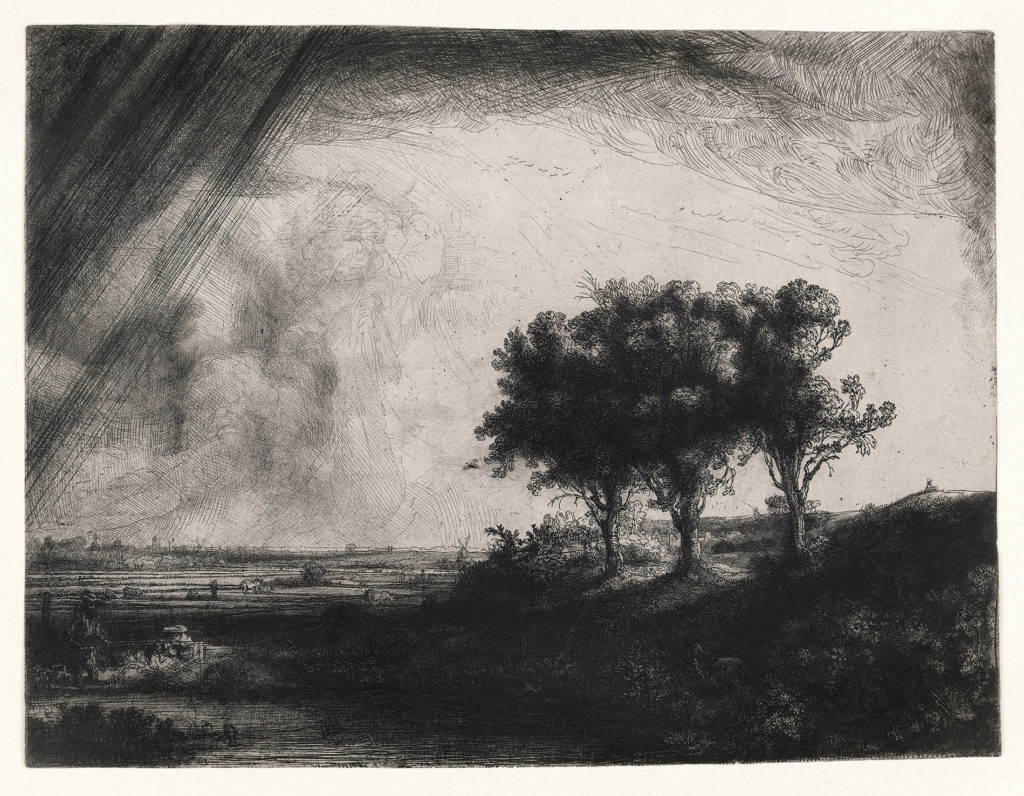The Three Trees, the most famous of Rembrandt’s landscapes, must also rank as one of the most majestic and evocative representations of the natural world ever committed to paper, which influenced centuries of artists. In The Three Trees, his largest landscape print, Rembrandt portrays a limitless view of Dutch scenery, dramatically orchestrated with marked contrasts of light and dark and other atmospheric effects. It is an ecstatic celebration of the natural world, vividly depicted in all its changeability and powerful vitality. The sky is an essay in meteorological activity: gusts of wind and moisture-laden thunderclouds pass over the landscape, unleashing a downpour of rain on the left, while the entire right side of the composition is suffused in sunlight. Les Météores section of the Discours sur le Méthode by Descartes, published in 1637, a comparable atmosphere is described by the philosopher and illustrated in a diagrammatic engraving by Franz van Schooten. Dark streaks for the sunlight, rising vapours, and traversing cloud are there analyzed in a formal composition that echoes in the Rembrandt composition, whose patron Constantijn Huygens assisted enthusiastically in the production of the illustration.
Dominating this area and standing out starkly against the burst of light are the three majestic trees, the sturdy trunks of which contrast markedly with the ephemeral conditions. The branches and leaves have grown into each other, forming a massive bouquet, and the small bird flying out of the foliage adds an idyllic note. We do not know whether Rembrandt intended his landscape to have a pantheistic message, but this has not prevented commentators from seeking an underlying symbolism in the print or, even more specifically, from viewing the motif of the trees as an evocation of the three crosses on Calvary. There is an association set by the artist about vanitas, i.e. our ephemeral, shifting conditions caught for timeless contemplation.
The present sheet here is a very fine and powerful impression, with intact burr and unworn tinting, full of contrast and strength. Hinterding lists four impressions with the same watermark, and set that prints on this watermarked sheet are, in so excellent overall quality, of great rarity. It is in good condition, as often cut on the platemark, which is complete and shows as usual a slight reduction on right edge. Nowell-Usticke listed the sheet with “RR”, i.e. means “very scarce/rare”, and there are no late prints There are impressions with less and more tone, with of course various subjective opinions about.
Rembrandt’s use of a combination of different techniques in The Three Trees – etching, drypoint and engraving, as well as plate tone, here noticeable at left in the sky and in the foreground – underlines his ambition for this masterpiece with its compelling range of effects. As we look deeper into this vast landscape, we notice that it is also animated by human presence: there are rustic cottages nestled in the patch of light beneath the trees, and on the skyline a cart full of peasants makes its way slowly along. Farther to the right an artist sits sketching; in the lower left, a man, accompanied by his wife, casts a fishing line into a stretch of water. Behind them the vista spreads out across flat meadows and still waterways, which reflect the turbulent mood of the sky and take our eye to the town on the distant horizon. The literature recently set a couple in the bushes, lower right corner, but in fact only the female figure is visible, and hardly, even on dryer or clearer impressions.
The present fact-sheet is inspired by the both excellent Peter Raissis in Prints & drawings Europe 1500–1900, Sydney, 2014, p. 86; and Martin Royalton-Kisch in Rembrandt the Printmaker, London, 2000, p. 207







